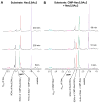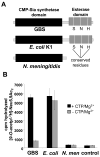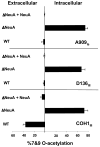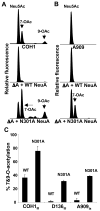NeuA sialic acid O-acetylesterase activity modulates O-acetylation of capsular polysaccharide in group B Streptococcus
- PMID: 17646166
- PMCID: PMC2588433
- DOI: 10.1074/jbc.M700340200
NeuA sialic acid O-acetylesterase activity modulates O-acetylation of capsular polysaccharide in group B Streptococcus
Abstract
Group B Streptococcus (GBS) is a common cause of neonatal sepsis and meningitis. A major GBS virulence determinant is its sialic acid (Sia)-capped capsular polysaccharide. Recently, we discovered the presence and genetic basis of capsular Sia O-acetylation in GBS. We now characterize a GBS Sia O-acetylesterase that modulates the degree of GBS surface O-acetylation. The GBS Sia O-acetylesterase operates cooperatively with the GBS CMP-Sia synthetase, both part of a single polypeptide encoded by the neuA gene. NeuA de-O-acetylation of free 9-O-acetyl-N-acetylneuraminic acid (Neu5,9Ac(2)) was enhanced by CTP and Mg(2+), the substrate and co-factor, respectively, of the N-terminal GBS CMP-Sia synthetase domain. In contrast, the homologous bifunctional NeuA esterase from Escherichia coli K1 did not display cofactor dependence. Further analyses showed that in vitro, GBS NeuA can operate via two alternate enzymatic pathways: de-O-acetylation of Neu5,9Ac(2) followed by CMP activation of Neu5Ac or activation of Neu5,9Ac(2) followed by de-O-acetylation of CMP-Neu5,9Ac(2). Consistent with in vitro esterase assays, genetic deletion of GBS neuA led to accumulation of intracellular O-acetylated Sias, and overexpression of GBS NeuA reduced O-acetylation of Sias on the bacterial surface. Site-directed mutagenesis of conserved asparagine residue 301 abolished esterase activity but preserved CMP-Sia synthetase activity, as evidenced by hyper-O-acetylation of capsular polysaccharide Sias on GBS expressing only the N301A NeuA allele. These studies demonstrate a novel mechanism regulating the extent of capsular Sia O-acetylation in intact bacteria and provide a genetic strategy for manipulating GBS O-acetylation in order to explore the role of this modification in GBS pathogenesis and immunogenicity.
Figures








Similar articles
-
NeuA O-acetylesterase activity is specific for CMP-activated O-acetyl sialic acid in Streptococcus suis serotype 2.Biochem Biophys Res Commun. 2011 Jul 1;410(2):212-7. doi: 10.1016/j.bbrc.2011.05.092. Epub 2011 May 23. Biochem Biophys Res Commun. 2011. PMID: 21624352
-
Discovery and characterization of sialic acid O-acetylation in group B Streptococcus.Proc Natl Acad Sci U S A. 2004 Jul 27;101(30):11123-8. doi: 10.1073/pnas.0403010101. Epub 2004 Jul 19. Proc Natl Acad Sci U S A. 2004. PMID: 15263085 Free PMC article.
-
The group B streptococcal sialic acid O-acetyltransferase is encoded by neuD, a conserved component of bacterial sialic acid biosynthetic gene clusters.J Biol Chem. 2006 Apr 21;281(16):11186-92. doi: 10.1074/jbc.M513772200. Epub 2006 Feb 20. J Biol Chem. 2006. PMID: 16490781
-
Functions and Biosynthesis of O-Acetylated Sialic Acids.Top Curr Chem. 2015;366:1-30. doi: 10.1007/128_2011_310. Top Curr Chem. 2015. PMID: 22371169 Free PMC article. Review.
-
Mobile contingency locus controlling Escherichia coli K1 polysialic acid capsule acetylation.Mol Microbiol. 2006 May;60(4):828-37. doi: 10.1111/j.1365-2958.2006.05158.x. Mol Microbiol. 2006. PMID: 16677296 Review.
Cited by
-
Structural and enzymatic characterization of NanS (YjhS), a 9-O-Acetyl N-acetylneuraminic acid esterase from Escherichia coli O157:H7.Protein Sci. 2011 Jul;20(7):1208-19. doi: 10.1002/pro.649. Epub 2011 May 31. Protein Sci. 2011. PMID: 21557376 Free PMC article.
-
The sialate O-acetylesterase EstA from gut Bacteroidetes species enables sialidase-mediated cross-species foraging of 9-O-acetylated sialoglycans.J Biol Chem. 2017 Jul 14;292(28):11861-11872. doi: 10.1074/jbc.M116.769232. Epub 2017 May 19. J Biol Chem. 2017. PMID: 28526748 Free PMC article.
-
Sialic acid metabolism and sialyltransferases: natural functions and applications.Appl Microbiol Biotechnol. 2012 May;94(4):887-905. doi: 10.1007/s00253-012-4040-1. Epub 2012 Apr 13. Appl Microbiol Biotechnol. 2012. PMID: 22526796 Free PMC article. Review.
-
Group B Streptococcus suppression of phagocyte functions by protein-mediated engagement of human Siglec-5.J Exp Med. 2009 Aug 3;206(8):1691-9. doi: 10.1084/jem.20090691. Epub 2009 Jul 13. J Exp Med. 2009. PMID: 19596804 Free PMC article.
-
Attenuation of Streptococcus suis virulence by the alteration of bacterial surface architecture.Sci Rep. 2012;2:710. doi: 10.1038/srep00710. Epub 2012 Oct 5. Sci Rep. 2012. PMID: 23050094 Free PMC article.
References
Publication types
MeSH terms
Substances
Grants and funding
LinkOut - more resources
Full Text Sources
Other Literature Sources

